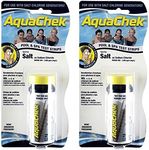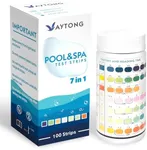Buying Guide for the Best Swimming Pool Test Strips
Choosing the right swimming pool test strips is essential for maintaining a clean and safe swimming environment. Test strips help you monitor the chemical levels in your pool, ensuring that the water is balanced and free from harmful contaminants. When selecting test strips, it's important to understand the key specifications and how they relate to your specific needs. This guide will help you navigate through the important features to consider, so you can make an informed decision and keep your pool in optimal condition.Parameters TestedThis spec refers to the different chemical levels that the test strips can measure, such as pH, chlorine, alkalinity, and hardness. It's important because each parameter affects the overall health and safety of your pool water. Basic test strips might only measure pH and chlorine, which are essential for maintaining water balance and sanitation. More advanced strips can test additional parameters like total alkalinity, cyanuric acid, and calcium hardness, providing a more comprehensive analysis. Choose test strips that test for the parameters most relevant to your pool maintenance routine. If you have a simple pool setup, basic strips may suffice, but for more complex systems or frequent use, opt for strips that offer a broader range of tests.
AccuracyAccuracy refers to how close the test strip readings are to the actual chemical levels in your pool. This is crucial because inaccurate readings can lead to improper chemical adjustments, which can affect water quality and safety. Test strips with higher accuracy provide more reliable results, helping you maintain the correct chemical balance. Accuracy can vary between brands and types of test strips, so look for products that are known for their precision. If you are meticulous about pool maintenance or have had issues with water quality in the past, prioritize accuracy in your choice of test strips.
Ease of UseEase of use describes how simple and straightforward it is to use the test strips. This includes how easy it is to dip the strip in the water, read the results, and interpret the color changes. It's important because complicated or difficult-to-read strips can lead to user error and incorrect chemical adjustments. Test strips that are easy to use typically have clear instructions, quick reaction times, and distinct color changes that are easy to match with the provided chart. If you are new to pool maintenance or prefer a hassle-free process, look for test strips that are designed for ease of use.
Shelf LifeShelf life refers to the length of time the test strips remain effective and accurate when stored properly. This is important because expired test strips can give inaccurate readings, leading to improper pool maintenance. Test strips with a longer shelf life are more convenient and cost-effective, as they can be used over an extended period without losing accuracy. Check the expiration date on the packaging and consider how frequently you will be testing your pool. If you test your pool water regularly, a shorter shelf life may not be an issue, but for occasional testing, opt for strips with a longer shelf life.
PackagingPackaging refers to how the test strips are stored and protected. Good packaging is important because it helps keep the strips dry and free from contamination, ensuring accurate readings. Test strips are often packaged in moisture-resistant containers or individually wrapped to maintain their integrity. Consider the packaging if you live in a humid environment or plan to store the strips for an extended period. Choose packaging that offers good protection to ensure the strips remain effective until their expiration date.






















